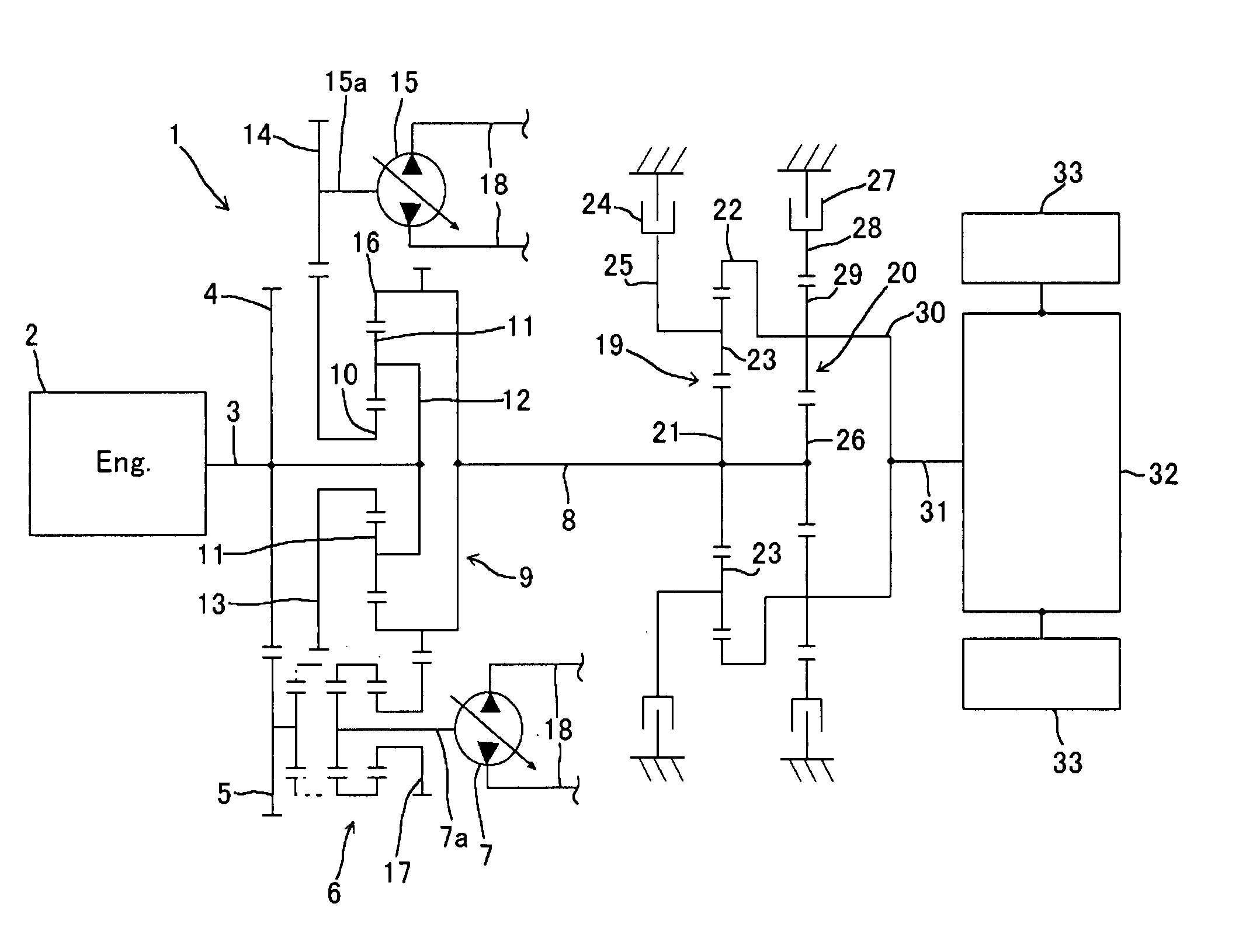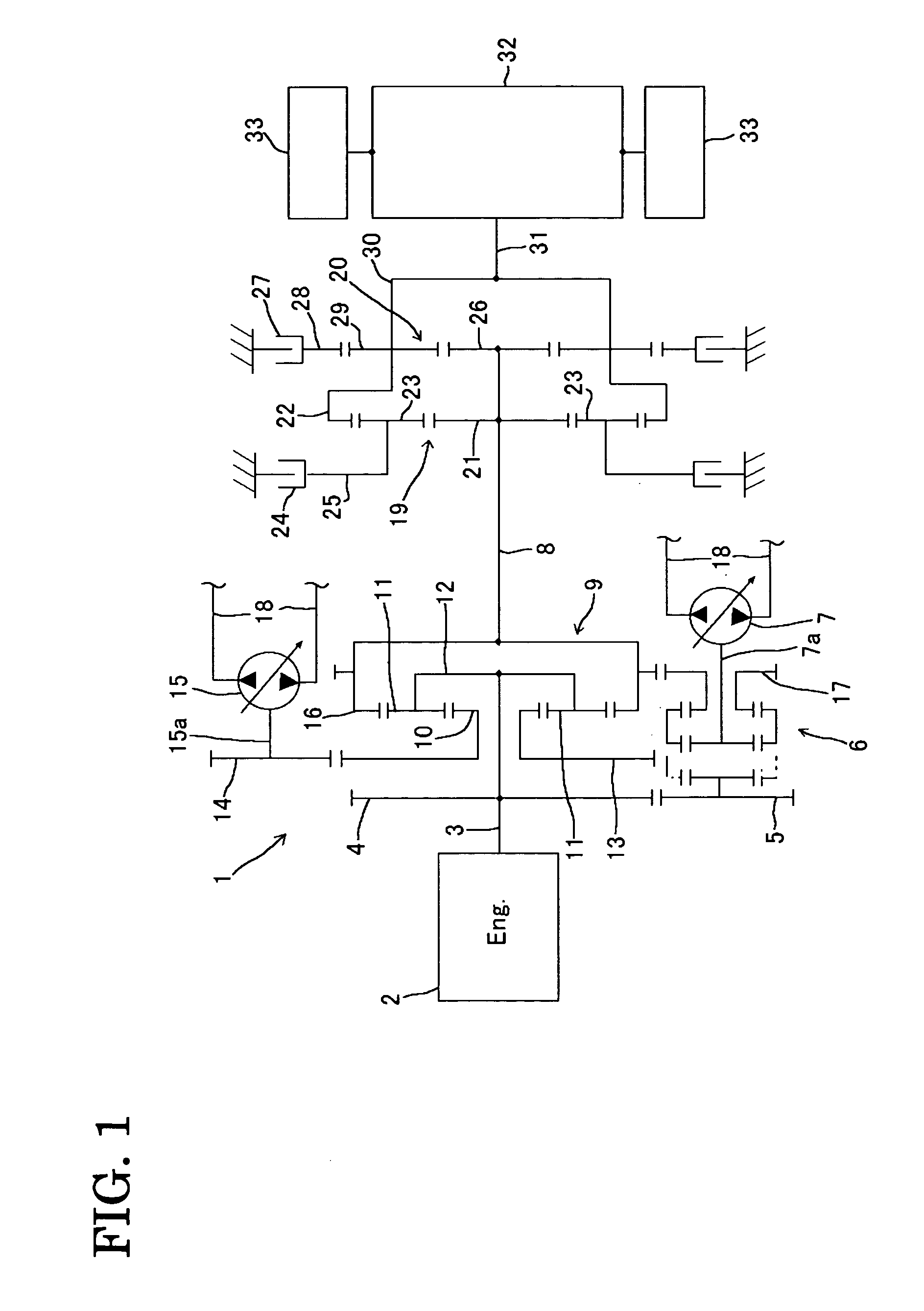Speed-changing device
a technology of speed-changing devices and mechanical units, which is applied in the direction of fluid gearings, transportation and packaging, gearing, etc., can solve the problems of poor efficiency, disadvantageous economic efficiency, and deterioration of the transmission efficiency of mechanical units, so as to reduce the capacity of pump-motors, increase efficiency, and increase the effect of capacity
- Summary
- Abstract
- Description
- Claims
- Application Information
AI Technical Summary
Benefits of technology
Problems solved by technology
Method used
Image
Examples
first embodiment
[0058]FIG. 1 is a schematic structural diagram of a transmission constructed according to a first embodiment of the invention. While the invention is applied to the transmission of a track-type vehicle such as bulldozers in this embodiment, it is obvious that the invention is not limited to this application.
[0059] In a transmission 1 constructed according to this embodiment, a first gear 4 is secured to an input shaft 3 to which motive power from an engine 2 is input. A second gear 5 meshes with the first gear 4 such that the second gear 5 can be coupled to a shaft 7a of a first pump-motor 7 through a synchromesh mechanism 6. The synchromesh mechanism 6 is situated between the second gear 5 and a fifth gear 17 (described later), and upon switching of the synchromesh mechanism 6, the rotation of the shaft 7a is selectively brought into synchronization with the rotation of the second gear 5 or the rotation of the fifth gear 17.
[0060] Disposed between the input shaft 3 and an interme...
second embodiment
[0086]FIG. 8 shows a schematic structural diagram of a transmission according to a second embodiment of the invention. The transmission 1A of the second embodiment does not basically differ from that of the first embodiment except the structure of a speed-change planetary gear mechanism 9A. Therefore, the parts of the second embodiment which correspond to those of the first embodiment are identified by the same reference numerals as of the first embodiment and a detailed description of them is skipped herein (the same applies to each of the following embodiments).
[0087] In the speed-change planetary gear mechanism 9A of the second embodiment, the sun gear 10 is rotatably borne by the input shaft 3 and the ring gear 16 is fixed to the input shaft 3. The planetary carrier 12 for bearing the planetary gears 11 is fixed to the intermediate output shaft 8. Meshing with the outer circumference of the planetary carrier 12 is the fifth gear 17.
[0088] In the transmission 1A of the second e...
third embodiment
[0090]FIG. 9 shows a schematic structural diagram of a transmission according to a third embodiment of the invention.
[0091] In a speed-change planetary gear mechanism 9B according to the third embodiment, the sun gear 10 is fixed to the input shaft 3 and the ring gear 16 is fixed to the intermediate output shaft 8. The fifth gear 17 meshes with the outer circumference of the ring gear 16. The planetary carrier 12 for bearing the planetary gears 11 is integrally coupled to the third gear 13.
[0092] In the transmission 1B of the third embodiment, if the shaft 7a of the first pump-motor 7 is coupled to the second gear 5 side while the rotating speed of the intermediate output shaft 8 is on the speed-up side, the motive power of the engine 2 is input to the sun gear 10 whereas the motive power of the second pump-motor 15 serving as a motor is input to the planetary gear 12, so that these motive powers are combined and output as the rotary motion of the ring gear 16 to be transmitted to...
PUM
 Login to View More
Login to View More Abstract
Description
Claims
Application Information
 Login to View More
Login to View More - R&D
- Intellectual Property
- Life Sciences
- Materials
- Tech Scout
- Unparalleled Data Quality
- Higher Quality Content
- 60% Fewer Hallucinations
Browse by: Latest US Patents, China's latest patents, Technical Efficacy Thesaurus, Application Domain, Technology Topic, Popular Technical Reports.
© 2025 PatSnap. All rights reserved.Legal|Privacy policy|Modern Slavery Act Transparency Statement|Sitemap|About US| Contact US: help@patsnap.com



